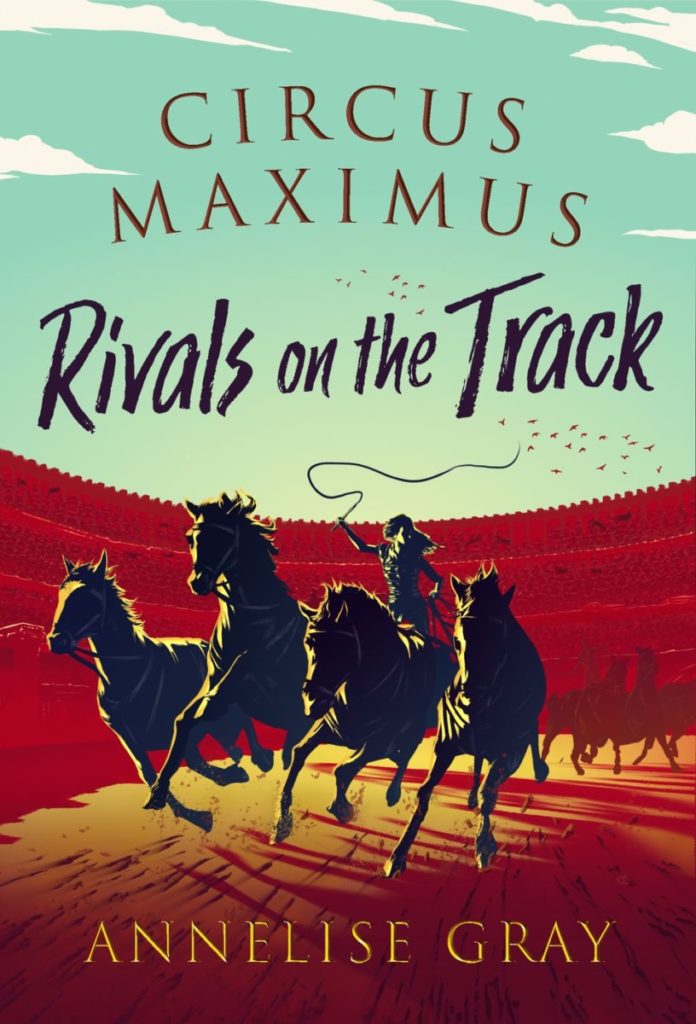Your cart is currently empty!

Annelise
Gray
I was really lucky that I got the chance to be around horses from an early age. My mother longed for a pony of her own when she was little, but never had one. So when she had children of her own, she arranged for my brother and me to have riding lessons at the stable down the road from the house in Bermuda where I grew up.
Annelise Gray

Rivals on the Track was an eagerly anticipated sequel to the action packed and thrilling ‘Circus Maximus Race to the Death’ and it did not disappoint. A 5 laurel crowns out of 5 read.
Rivals on the Track is brilliantly immersive. The action starts almost straight away picking up from the previous story seamlessly. Dido is a cleverly conceived protagonist and through her story we continue to learn more about the attitudes towards women and girls in Roman times as well as the adrenal fueled Chariot racing. This sequel is more than a story about chariot racing and danger on the track. It is a hugely entertaining and fast paced read filled with family secrets, hatred, jealousy, enemies of old and the long reach of Emperor Caligula. Whilst, like the first title in the series, most of the situations and characters are fictional, the setting for the main action is based on extensive historical research. Annelise Gray brings history to life and this is undeniably a perfect historical tale for readers aged 9+.
In Rivals on the Track, Dido again races for victory in a circus but this time one built in honour of Emperor Caligula. How important was it to keep that link with Caligula?
Emperor Caligula certainly looms large in Rivals on the Track. At the end of Race to the Death, Dido and her beloved horse Porcellus escaped Caligula’s clutches. As Rivals on the Track begins, she knows that the danger she faces from the emperor hasn’t gone away – he is still trying to hunt her down and is offering a reward for her capture.
Then Dido is faced with a choice – to stay in hiding or risk blowing her cover by returning to the racetrack in order to help her family, who face financial ruin if she doesn’t. This is where much of the sense of jeopardy in Rivals on the Track comes from. And the threat Caligula poses to Dido doesn’t end on the last page of this book…however, my lips are sealed on that subject for the time being.
You grew up with horses. How much of your own experience have you incorporated into Dido’s love of horses?
I was really lucky that I got the chance to be around horses from an early age. My mother longed for a pony of her own when she was little, but never had one. So when she had children of her own, she arranged for my brother and me to have riding lessons at the stable down the road from the house in Bermuda where I grew up.
I was never a girl racer, like Dido, but riding was very important to me and gave me a lot of my sense of self when I was young. It made me feel intrepid and independent, when shy and cautious was my default setting. Even though I don’t ride now, I remember so well the joy of being around horses – that lovely smell they have, the soft, ticklish feeling of them feeding from your hand and the trust you can build with them. I draw on all of that when I’m describing Dido’s own relationship with horses.
There is a clear love of history that flows within your stories. Did you always enjoy history at school? Was Ancient Rome your favourite period?
I did love history and it was definitely one of my favourite subjects. I also really enjoyed reading historical novels or novels that were written a long time ago. I still do. I’m fascinated by all the little contextual detail that make you feel as though you’ve been transported into another world – the clothes and customs, the houses and how they were furnished, what was eaten, the turns of phrase. It’s the next best thing to time travel and I think it can be a useful introduction to a particular historical period.
I learned about the history of Ancient Rome mainly through studying Latin, which I began when I was thirteen. The coursebook we used in that first year was called the Cambridge Latin Course and it was about a family living in Pompeii in the months leading up to the eruption of Mount Vesuvius. I remember poring over the pictures alongside the Latin passages, marvelling at the fact that there’s a charred loaf of bread from a Pompeian baker’s oven that survives two thousand years on, and that you can still walk on the stepping stones that the people of Pompeii used to cross the street. It brought this supposedly ‘dead’ language alive for me and inspired me to study Classics at university some years later.
Family is important to Dido and in Rivals on the Track a little more of her mother’s story is revealed particularly with the discovery of the wooden box and the little set of charioteers. Do you have or would you have a ‘memory/treasure’ box? What item reveals most about you or which item would you consider most precious?
There is a collection of my toy ponies from childhood still at my parents’ house and I’m embarrassed to say that I’ve more than once forbidden my mother to give them away – I probably need to take a lesson from Andy in Toy Story 3 and let them go. But probably my most precious memento of childhood – because of what it signifies – is a copy of the film screenplay of The Princess Bride, signed by the main cast. It was given to me by my older brother (in our grown-up years) in recognition of the fact that it was our favourite film when we were children. I hero-worshipped my brother, whereas I think he only suffered my company under duress. However, we could both quote this film verbatim and always laughed in the same bits. (We’re good friends these days).
There is almost a parallel story between Jewel and Dido. Did you consciously decide that Jewel would be a mare and therefore not be considered ‘good enough’ to be used in the race just as Dido, as a girl, could not ever be considered ‘good enough’ to race?
That’s a great observation about Jewel and Dido. I did indeed make the conscious decision that she would be a mare, after reading about the fact that the Romans had a similar attitude towards female horses as they did towards women – in other words, they just didn’t think they were as good as the males. I thought it would be fun to have an equine character that had to overcome prejudice just as Dido does.
Aside from Dido, which other character did you enjoy creating and developing and why? Are they entirely fictional or a re-imagination of a real person?
It’s a little bit of a spoiler, but I especially enjoyed writing the character of Dido’s grandfather, Muttumbaal, in this novel. He is stubborn and complicated, but also charismatic and brilliant in his way, and the relationship between him and Dido (as well as between him and his son, Dido’s Uncle Scorpus) is an interesting one. He’s entirely fictional, though I’m sure my portrait of him is influenced by other curmudgeonly ‘trainer’ characters such as Henry Dailey, played by Mickey Rooney in the film version of The Black Stallion, or Ian Holm’s depiction of the athletics coach Sam Mussabini in Chariots of Fire.
There is a lot of interest in Graphic Novels at this current time. Have you considered this for the Circus Maximus series?
I hadn’t, actually, but it’s a brilliant idea! I’d love that, if any graphic artists want to get in touch….
What are your plans for the immediate future? Do you have more plans for Dido and Circus Maximus or are you currently working on something new?
I’m very happy to say that Dido will indeed return in the third volume of the Circus Maximus series, Rider of the Storm, which is coming out in March. I’m hard at work on the edits now.
Can you describe Rivals on the Track in three words?
Risk. Rivalry. Redemption.

Q & A hosted by
Valda Varadinek